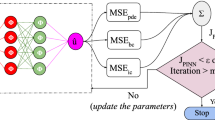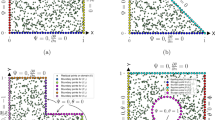Abstract
Deep learning has been increasingly recognized as a promising tool in solving kinds of physical problems beyond powerful approximations. A multi-domain physics-informed neural network (mPINN) is proposed to solve the non-uniform heat conduction and conjugate natural convection with the discontinuity of temperature gradient on the interface. Local radial basis function method (LRBF) is applied to compute the case without the analytical solution and is regarded as the benchmark solver. Each physical domain matches a private neural network and all neural networks are connected by the shared information of temperature and heat flux on the interface. Joint training and separate training are utilized to minimize the loss function, which usually consists of the residual of boundary conditions, interface conditions and governing equations. Joint training minimizes the sum of all losses from neural networks with one shared optimizer, while separate training owns its private optimizer. Local adaptive activation function (LAAF) is used to accelerate the convergence and acquire a lower loss value when compared with its fixed counterpart. The numerical experiments on three types of residual points, uniform, Gauss-Lobatto and random, are conducted and it can be concluded that the uniform residual points can obtain the most accurate solution than the random and Gauss-Lobatto. Joint training is more accurate than the separate training when the number of residual points is relatively small, while the separate training performs better than the joint training for the large number of residual points. Numerous test cases on multi-domain heat transfer and fluid flow show the accuracy of the proposed mPINN. Local and global heat transfer rates show good agreements with the results from LRBF. Excepting the forward problems, the thermal conductivity ratio, the constant source and the characteristic parameters of natural convection are accurately learned from sparsely distributed data points.
Similar content being viewed by others
References
Dissanayake M W M G, Phan-Thien N. Neural-network-based approximations for solving partial differential equations. Commun Numer Meth Engng, 1994, 10: 195–201
González-García R, Rico-Martínez R, Kevrekidis I G. Identification of distributed parameter systems: A neural net based approach. Comput Chem Eng, 1998, 22: S965–S968
Lagaris I E, Likas A, Fotiadis D I. Artificial neural networks for solving ordinary and partial differential equations. IEEE Trans Neural Netw, 1998, 9: 987–1000
Hornik K, Stinchcombe M, White H. Multilayer feedforward networks are universal approximators. Neural Networks, 1989, 2: 359–366
Chen T P, Chen H. Universal approximation to nonlinear operators by neural networks with arbitrary activation functions and its application to dynamical systems. IEEE Trans Neural Netw, 1995, 6: 911–917
Mall S, Chakraverty S. Application of legendre neural network for solving ordinary differential equations. Appl Soft Comput, 2016, 43: 347–356
Panghal S, Kumar M. Optimization free neural network approach for solving ordinary and partial differential equations. Eng Comput, 2020, 37: 2989–3002
Yang Y, Hou M, Luo J. A novel improved extreme learning machine algorithm in solving ordinary differential equations by Legendre neural network methods. Adv Differ Equ, 2018, 2018: 469
Lorin E. Derivation and analysis of parallel-in-time neural ordinary differential equations. Ann Math Artif Intell, 2020, 88: 1035–1059
Mao Z, Jagtap A D, Karniadakis G E. Physics-informed neural networks for high-speed flows. Comput Methods Appl Mech Eng, 2020, 360: 112789
Baydin A G, Pearlmutter B A, Radul A A, et al. Automatic differentiation in machine learning. J Mach Learn Res, 2017, 18: 5595–5637
Lu L, Meng X, Mao Z, et al. DeepXDE: A deep learning library for solving differential equations. SIAM Rev, 2021, 63: 208–228
Poggio T, Mhaskar H, Rosasco L, et al. Why and when can deep-but not shallow-networks avoid the curse of dimensionality: A review. Int J Autom Comput, 2017, 14: 503–519
Cai S, Mao Z, Wang Z, et al. Physics-informed neural networks (PINNs) for fluid mechanics: A review. Acta Mech Sin, 2021, 37: 1727–1738
Raissi M, Perdikaris P, Karniadakis G E. Physics-informed neural networks: A deep learning framework for solving forward and inverse problems involving nonlinear partial differential equations. J Comput Phys, 2019, 378: 686–707
Pang G, Lu L, Karniadakis G E. fPINNs: Fractional physics-informed neural networks. Siam J Sci Comput, 2019, 41: A2603–A2626
Zhang D, Lu L, Guo L, et al. Quantifying total uncertainty in physics-informed neural networks for solving forward and inverse stochastic problems. J Comput Phys, 2019, 397: 108850
Zhang D, Guo L, Karniadakis G E. Learning in modal space: Solving time-dependent stochastic PDEs using physics-informed neural networks. Siam J Sci Comput, 2020, 42: A639–A665
Jin X, Cai S, Li H, et al. NSFnets (Navier-Stokes flow nets): Physics-informed neural networks for the incompressible Navier-Stokes equations. J Comput Phys, 2021, 426: 109951
Jagtap A D, Kharazmi E, Karniadakis G E. Conservative physics-informed neural networks on discrete domains for conservation laws: Applications to forward and inverse problems. Comput Methods Appl Mech Eng, 2020, 365: 113028
Jagtap A D, Karniadakis G E. Extended physics-informed neural networks (XPINNs): A generalized space-time domain decomposition based deep learning framework for nonlinear partial differential equations. Commun Comput Phys, 2020, 28: 2002–2041
Raissi M, Yazdani A, Karniadakis G E. Hidden fluid mechanics: Learning velocity and pressure fields from flow visualizations. Science, 2020, 367: 1026–1030
Rao C, Sun H, Liu Y. Physics-informed deep learning for incompressible laminar flows. Theor Appl Mech Lett, 2020, 10: 207–212
Zhang R, Liu Y, Sun H. Physics-informed multi-LSTM networks for metamodeling of nonlinear structures. Comput Methods Appl Mech Eng, 2020, 369: 113226
Meng X, Li Z, Zhang D, et al. PPINN: Parareal physics-informed neural network for time-dependent PDEs. Comput Methods Appl Mech Eng, 2020, 370: 113250
Wang S, Teng Y, Perdikaris P. Understanding and mitigating gradient flow pathologies in physics-informed neural networks. Siam J Sci Comput, 2021, 43: A3055–A3081
Wang S, Yu X, Perdikaris P. When and why PINNs fail to train: A neural tangent kernel perspective. J Comput Phys, 2022, 449: 110768
Xiang Z, Peng W, Zheng X, et al. Self-adaptive loss balanced physics-informed neural networks for the incompressible Navier-Stokes equations. arXiv: 2104.06217
Moseley B, Markham A, Nissen-Meyer T. Solving the wave equation with physics-informed deep learning. arXiv: 2006.11894
Jagtap A D, Kawaguchi K, Em Karniadakis G. Locally adaptive activation functions with slope recovery for deep and physics-informed neural networks. Proc R Soc A, 2020, 476: 2239
Jagtap A D, Kawaguchi K, Karniadakis G E. Adaptive activation functions accelerate convergence in deep and physics-informed neural networks. J Comput Phys, 2020, 404: 109136
Sukumar N, Srivastava A. Exact imposition of boundary conditions with distance functions in physics-informed deep neural networks. Comput Methods Appl Mech Eng, 2022, 389: 114333
Lagari P L, Tsoukalas L H, Safarkhani S, et al. Systematic construction of neural forms for solving partial differential equations inside rectangular domains, subject to initial, boundary and interface conditions. Int J Artif Intell Tools, 2020, 29: 2050009
Wang T, Huang Z, Sun Z, et al. Reconstruction of natural convection within an enclosure using deep neural network. Int J Heat Mass Transfer, 2021, 164: 120626
Patel R G, Manickam I, Trask N A, et al. Thermodynamically consistent physics-informed neural networks for hyperbolic systems. J Comput Phys, 2022, 449: 110754
Fuks O, Tchelepi H A. Limitations of physics informed machine learning for nonlinear two-phase transport in porous media. J Machine Learn Model Comput, 2020, 1: 19–37
Yu J, Lu L, Meng X, et al. Gradient-enhanced physics-informed neural networks for forward and inverse PDE problems. Comput Methods Appl Mech Eng, 2022, 393: 114823
Lou Q, Meng X, Karniadakis G E. Physics-informed neural networks for solving forward and inverse flow problems via the Boltzmann-BGK formulation. J Comput Phys, 2021, 447: 110676
Ruder S. An overview of gradient descent optimization algorithms. arXiv: 1609.04747
Wang T, Huang Z, Sun Z, et al. Numerical simulation of mixed flow past an inclined square cylinder using a local radial basis function method. In: Proceedings of the ASME-JSME-KSME 2019 8th Joint Fluids Engineering Conference, AJKFluids, 2019. American Society of Mechanical Engineers (ASME). San Francisco, 2019
Wang T, Huang Z, Xi G. Entropy generation for mixed convection in a square cavity containing a rotating circular cylinder using a local radial basis function method. Int J Heat Mass Transfer, 2017, 106: 1063–1073
Wang T, Wang Z, Xi G, et al. Periodic unsteady mixed convection in square enclosure induced by inner rotating circular cylinder with time-periodic pulsating temperature. Int J Heat Mass Transfer, 2017, 111: 1250–1259
Kansa E J. Multiquadrics—A scattered data approximation scheme with applications to computational fluid-dynamics—II solutions to parabolic, hyperbolic and elliptic partial differential equations. Comput Math Appl, 1990, 19: 147–161
Kansa E J. Multiquadrics—A scattered data approximation scheme with applications to computational fluid-dynamics—I surface approximations and partial derivative estimates. Comput Math Appl, 1990, 19: 127–145
Ha M Y, Jung M J. A numerical study on three-dimensional conjugate heat transfer of natural convection and conduction in a differentially heated cubic enclosure with a heat-generating cubic conducting body. Int J Heat Mass Transfer, 2000, 43: 4229–4248
Zhao F Y, Liu D, Tang G F. Determining boundary heat flux profiles in an enclosure containing solid conducting block. Int J Heat Mass Transfer, 2010, 53: 1269–1282
Author information
Authors and Affiliations
Corresponding author
Additional information
This work was supported by the National Natural Science Foundation of China (Grant Nos. 12102331 and 52130603).
Rights and permissions
About this article
Cite this article
Wang, T., Wang, Z., Huang, Z. et al. Multi-domain physics-informed neural network for solving heat conduction and conjugate natural convection with discontinuity of temperature gradient on interface. Sci. China Technol. Sci. 65, 2442–2461 (2022). https://doi.org/10.1007/s11431-022-2118-9
Received:
Accepted:
Published:
Issue Date:
DOI: https://doi.org/10.1007/s11431-022-2118-9




